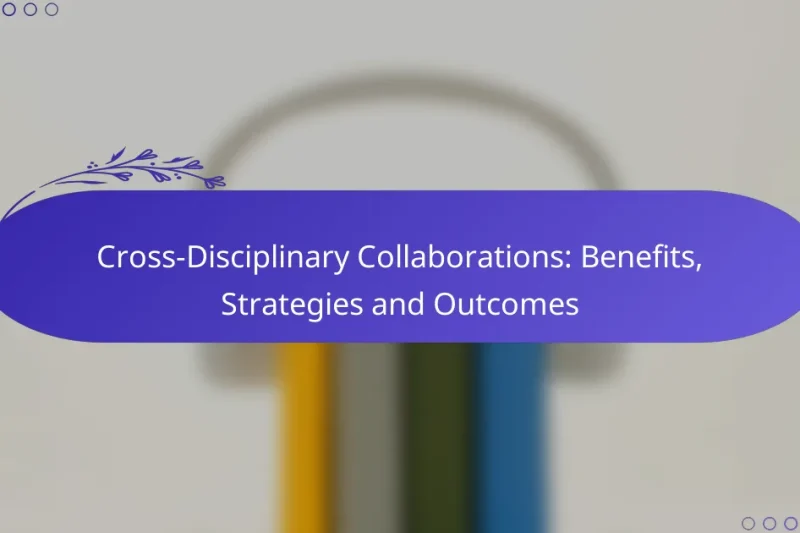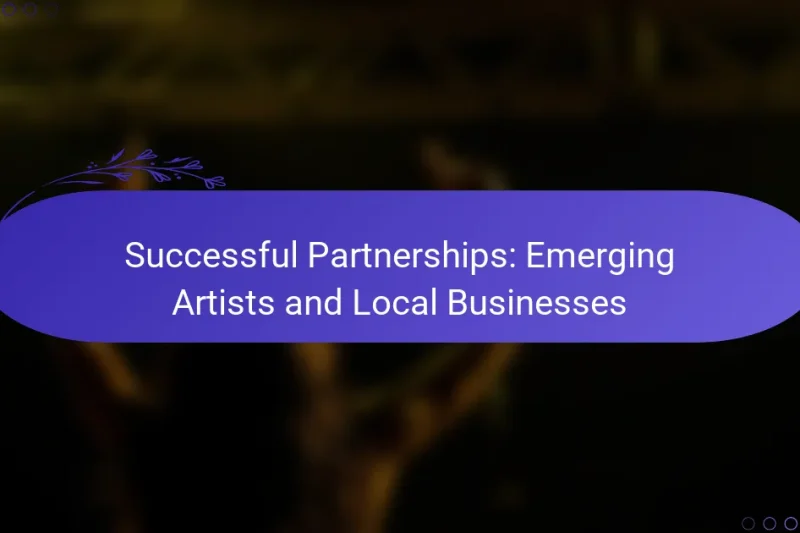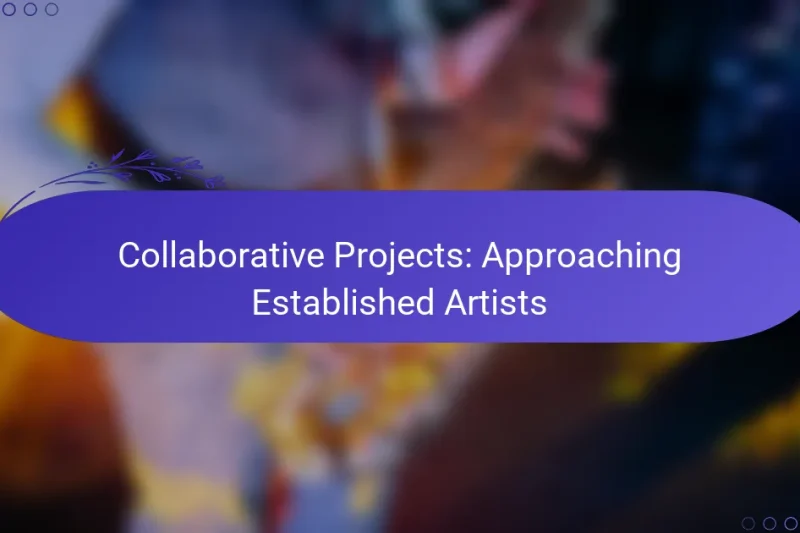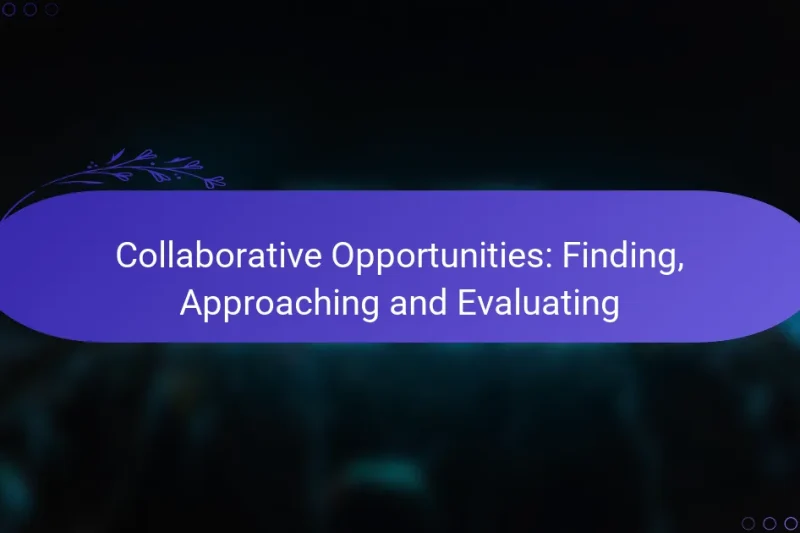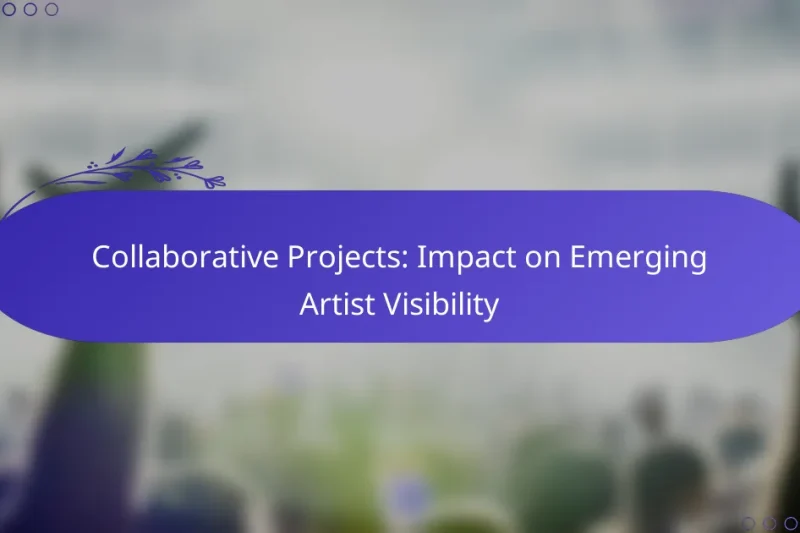Cross-disciplinary collaborations harness the strengths of diverse expertise to drive innovation and enhance problem-solving capabilities. By … Cross-Disciplinary Collaborations: Benefits, Strategies and OutcomesRead more
Emerging Artist Spotlights: Collaborations and Partnerships
Emerging artists are increasingly leveraging collaborations and partnerships to enhance their visibility and reach within the competitive art scene. By joining forces with other creatives or brands, they can tap into new audiences and expand their influence. These collaborations not only foster innovation and creativity but also open doors to commercial success and networking opportunities.
Art Collectives: Support, Collaboration and Community for Emerging Artists
Art collectives play a crucial role in supporting emerging artists by promoting collaboration and building a … Art Collectives: Support, Collaboration and Community for Emerging ArtistsRead more
Successful Partnerships: Emerging Artists and Local Businesses
Successful partnerships between emerging artists and local businesses can significantly enhance community engagement and visibility for … Successful Partnerships: Emerging Artists and Local BusinessesRead more
Collaborative Projects: Approaching Established Artists
Collaborating with established artists can elevate your creative projects by tapping into their experience and networks. … Collaborative Projects: Approaching Established ArtistsRead more
Partnerships with Influencers: Leveraging for Emerging Artist Promotion
Partnerships with influencers offer emerging artists a powerful avenue for promotion, enabling them to reach wider … Partnerships with Influencers: Leveraging for Emerging Artist PromotionRead more
Collaborative Opportunities: Finding, Approaching and Evaluating
Collaborative opportunities in advertising can significantly enhance your efforts by fostering valuable connections and partnerships. To … Collaborative Opportunities: Finding, Approaching and EvaluatingRead more
Collaborative Projects: Impact on Emerging Artist Visibility
Collaborative projects play a crucial role in increasing visibility for emerging artists by providing access to … Collaborative Projects: Impact on Emerging Artist VisibilityRead more
How do collaborations enhance emerging artists’ visibility?
Collaborations significantly boost emerging artists’ visibility by connecting them with broader audiences and established networks. By working with other artists or brands, they can tap into new fan bases and increase their exposure in the competitive art scene.
Increased audience reach
Collaborating with other artists allows emerging talents to reach audiences they may not have accessed independently. For example, a musician partnering with a visual artist for an album cover can attract fans from both fields, effectively doubling their potential audience.
Additionally, collaborations can occur across various platforms, such as social media, live performances, or exhibitions, further expanding visibility. Artists should consider targeting collaborators whose audiences align with their artistic vision for maximum impact.
Access to diverse resources
Collaborations provide emerging artists with access to resources that may otherwise be out of reach. This includes not only financial support but also equipment, studio space, and professional networks that can enhance their work quality and marketability.
For instance, a visual artist might gain access to high-quality printing services through a partnership with a gallery, enabling them to produce limited edition prints. Artists should seek partnerships that offer complementary skills and resources to leverage their strengths effectively.
Cross-promotion opportunities
Cross-promotion is a powerful tool for enhancing visibility, as it allows artists to market each other’s work to their respective audiences. This can take the form of joint social media campaigns, shared events, or collaborative projects that highlight both artists’ contributions.
For example, two musicians might host a joint concert, promoting it through their individual channels to maximize attendance. Artists should develop clear promotional strategies and timelines to ensure that both parties benefit equally from the collaboration.
What are successful collaboration examples in the music industry?
Successful collaborations in the music industry often involve artists combining their unique styles to create innovative sounds that resonate with audiences. These partnerships can enhance creativity, expand fan bases, and lead to commercial success.
Billie Eilish and Finneas
Billie Eilish and her brother Finneas O’Connell exemplify a highly successful collaboration in music. Their partnership has produced multiple chart-topping hits, including “Bad Guy” and “When the Party’s Over,” showcasing their ability to blend Eilish’s haunting vocals with Finneas’s minimalist production style.
Key elements of their collaboration include a strong understanding of each other’s artistic vision and a commitment to experimenting with sound. This synergy allows them to push boundaries while maintaining a cohesive artistic identity.
Post Malone and Swae Lee
The collaboration between Post Malone and Swae Lee on the track “Sunflower” highlights how two distinct artists can come together to create a massive hit. The song, featured in the “Spider-Man: Into the Spider-Verse” soundtrack, blends Post Malone’s melodic rap with Swae Lee’s smooth vocals, appealing to a wide audience.
This partnership demonstrates the importance of leveraging each artist’s strengths. By combining Post Malone’s mainstream appeal with Swae Lee’s unique sound, they achieved a track that topped charts and garnered significant streaming numbers, illustrating the potential of strategic collaborations in the music industry.
How can emerging artists find collaboration opportunities?
Emerging artists can find collaboration opportunities through various channels that connect them with other creatives and industry professionals. Engaging in networking events, utilizing social media, and participating in music industry forums are effective strategies to discover potential partners.
Networking events and festivals
Networking events and music festivals provide a platform for emerging artists to meet industry professionals and fellow musicians. Attending these gatherings allows artists to showcase their work, exchange ideas, and form relationships that may lead to collaborations.
To maximize benefits, artists should prepare a concise pitch about their music and have promotional materials ready, such as business cards or digital portfolios. Participating in workshops or panel discussions can also enhance visibility and credibility.
Social media platforms
Social media platforms like Instagram, TikTok, and Twitter are vital for emerging artists to connect with others in the industry. By sharing their music and engaging with followers, artists can attract potential collaborators who resonate with their style and vision.
Using relevant hashtags and participating in online challenges can increase reach. Artists should actively engage with other creators by commenting on their work and sharing collaborative posts to build relationships and foster opportunities.
Music industry forums
Music industry forums and online communities, such as Reddit’s r/WeAreTheMusicMakers or Gearslutz, are excellent resources for emerging artists seeking collaboration. These platforms allow artists to share their experiences, seek advice, and connect with others looking for partnerships.
When participating in forums, artists should contribute valuable insights and be open to feedback. Regularly checking for collaboration requests or posting their own can lead to fruitful connections and projects.
What criteria should artists consider when choosing collaborators?
Artists should evaluate several key criteria when selecting collaborators, including complementary styles, shared audience demographics, and mutual artistic goals. These factors can significantly enhance the effectiveness and reach of their collaborative efforts.
Complementary styles
Choosing collaborators with complementary styles can create a richer and more diverse artistic output. For example, a visual artist might partner with a musician whose sound enhances the emotional impact of their work. This synergy can attract a broader audience and elevate both artists’ profiles.
When assessing styles, consider how each artist’s strengths can fill gaps in the other’s work. A painter known for bold colors might collaborate with a sculptor who excels in minimalist designs, resulting in a dynamic exhibition that showcases both approaches.
Shared audience demographics
Collaborating with artists who share similar audience demographics can maximize engagement and exposure. Understanding the age, interests, and cultural backgrounds of both artists’ audiences allows for targeted marketing strategies that resonate with potential fans.
For instance, two artists with a following in the indie music scene might combine their efforts for a joint album release, tapping into each other’s fan base to boost visibility and sales. This approach can lead to increased ticket sales for live performances and higher streaming numbers.
Mutual artistic goals
Having mutual artistic goals is essential for a successful collaboration. Artists should discuss their visions and objectives upfront to ensure alignment and avoid conflicts later in the process. Clear communication about what each artist hopes to achieve can foster a more productive partnership.
For example, if both artists aim to raise awareness about social issues through their work, they can create pieces that complement each other and amplify their message. Establishing common goals can also help in setting timelines and measuring the success of the collaboration.
How do partnerships with brands benefit emerging artists?
Partnerships with brands provide emerging artists with essential resources and opportunities that can significantly enhance their careers. These collaborations can lead to financial backing, increased visibility, and access to valuable marketing tools.
Financial support for projects
Brand partnerships often come with financial support, which can be crucial for emerging artists looking to fund their projects. This funding can cover production costs, promotional activities, or even living expenses while they focus on their art.
For example, a brand might sponsor an artist’s album release or an art exhibition, providing the necessary capital to bring their vision to life. Such financial backing can range from a few hundred to several thousand dollars, depending on the scope of the project and the brand’s budget.
Increased brand exposure
Collaborating with established brands allows emerging artists to tap into a wider audience, significantly boosting their visibility. This exposure can lead to new fans, followers, and potential customers who may not have discovered the artist otherwise.
For instance, an artist featured in a brand’s advertising campaign or social media promotions can gain access to millions of viewers. This increased exposure can be a game-changer, helping artists build their reputations and expand their reach in the industry.
Access to marketing resources
Partnerships with brands often provide emerging artists with access to professional marketing resources that they might not have on their own. This can include everything from graphic design services to social media management and public relations support.
Utilizing these resources can help artists create a more polished image and effectively promote their work. For example, a brand may offer to manage an artist’s social media accounts, allowing them to focus on creating while ensuring their online presence is strong and engaging.
What are the challenges of collaborations for emerging artists?
Emerging artists often face several challenges when collaborating with others, including creative differences, communication issues, and resource constraints. These obstacles can hinder the collaborative process and impact the final outcome of their projects.
Creative differences
Creative differences arise when collaborators have varying artistic visions or styles. For emerging artists, this can lead to conflicts that may stall progress or result in unsatisfactory outcomes. It’s essential to establish a shared vision early in the collaboration to minimize misunderstandings.
To navigate creative differences, artists should engage in open discussions about their ideas and expectations. Setting clear goals and agreeing on a direction can help maintain focus and harmony. Regular check-ins throughout the collaboration can also ensure that everyone remains aligned.
For example, if two artists are working on a visual project, they might initially agree on a theme but later find themselves diverging in color palette choices. Addressing these differences promptly can prevent larger issues down the line.
